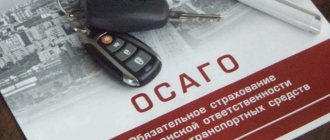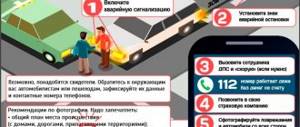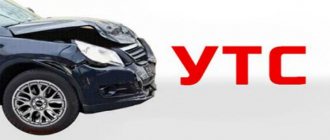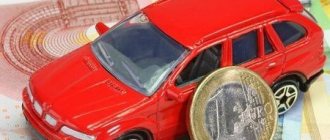Damage assessment under compulsory motor liability insurance
The procedure for paying compensation in the event of an accident is regulated by Law No. 40 of 2002 and Regulations of the Central Bank of Russia of 2014 No. 431-P.
In accordance with these regulations, payment is made on an application basis. Each fact in the application must be documented.
You can submit a claim to the insurance company:
- in which they are registered themselves (if there is no harm to life or health, and also if all participants in the accident have insurance);
- in which the culprit is registered (in any situation).
The responsibility for assessment rests with the insurance company. If the payment is underestimated, you have the right to contact an independent expert for a re-inspection. Subsequently (if the fact of underestimation of compensation is revealed), the costs can be recovered from the insurer.
Attention! Before the examination, do not take measures to repair the car.
Otherwise, disagreements may arise with the insurance company.
What is considered damage caused in an accident?
The condition for paying compensation for civil liability is that the insurer assumes responsibility for damage after an accident for its client. If the vehicle is subject to repair, the damage is considered partial.
If the vehicle is unprofitable to repair (the damage to the car after an accident exceeds its market value before the collision), we are dealing with total damage.
According to the changes that came into force on January 1, 2020 in the Federal Law of April 25, 2002 N 40, the insurance compensation paid by the insurance company cannot exceed for each:
- 500,000 rubles for damage caused to life and health;
- 400,000 rubles for damage caused to property.
When calculating the compensation to which the victim is entitled, the insurer must be guided by the principle that the amount of compensation must be equal to the amount of damage.
In case of partial damage, the compensation must be sufficient for repair. If the accident caused irreversible damage, then the compensation should be sufficient to purchase a similar car.
The vehicle is assessed after the victim contacts the insurer. The place for damage analysis can be the parking lot where the vehicle was taken by a tow truck or from an insurer (if the vehicle allows its operation).
It is quite difficult for the injured driver to independently assess the damage, since it is necessary to know the prices for parts and work of workshops, in accordance with the regional location.
Deadlines
The compensation period is 20 calendar days from the date of registration of the application for the occurrence of an insured event. It includes the process of inspecting the car and conducting an examination.
Notify the insurer if you do not provide the vehicle for inspection in a timely manner. The maximum delay period cannot exceed 20 days.
If you pass again, the documents and application will be returned. Contact again. The deadlines will begin to count from the date of submission of the new application.
Within 5 days from the date of submission of the application, you are obliged to provide the vehicle for inspection:
- Independently, if the car can move “under its own power”.
- An expert must arrive at its location if the car is too damaged.
If the vehicle is located in a hard-to-reach place, the inspection can be carried out within 10 days. The costs of the examination and the visit of the expert are borne by the insurance company.
If the insurer does not schedule an inspection within 5 days, contact an independent expert. In this case, his report is taken as the basis for calculating the amount of damage, and the insurance company loses the right to demand that the car be provided for inspection.
Important! There is no need to confuse a car inspection by an expert and an insurance specialist. To determine the amount of insurance compensation, you will need an examination conducted by an authorized person.
Unified calculation method
Resolution of the Central Bank of Russia of 2014 No. 433-P establishes a Unified methodology for calculating damage under compulsory motor liability insurance.
The main nuances of the unified methodology:
- Defects of the car are carried out during the initial inspection, but subsequently the list of damages may be increased.
- The amount is determined based on the cost of repairs on the date of the accident in a specific region.
- Payment under compulsory motor liability insurance is determined taking into account the wear and tear of components.
- The cost of usable parts (in case of total damage) is taken into account.
Taking into account the wear and tear of components when determining the amount of damage leads to the fact that the compensation received is not enough to restore the damage. If repairs are carried out at the expense of the insurance company, then the craftsmen use only new parts, the cost of which is higher than that of used ones.
That is, the victim finds himself in a situation where he is obliged to pay additional money to repair his car, even if he has insurance.
To avoid this, request a determination of the amount of compensation for loss of marketable value when assessing damage .
Cost of auto examination after an accident
Estimating the cost of car repairs consists of several components:
- car model and spare parts necessary for repair;
- cost of spare parts;
- degree of wear of parts;
- the nature of the injuries received;
- degree of complexity of dismantling, repair work, installation;
- availability of parts on the Russian market.
It is impossible to name an exact amount that unambiguously determines how much it will cost to examine a car in an accident, since this figure depends on several circumstances:
- in which subject of the Russian Federation the examination is carried out;
- how much damage the car received (determined visually);
- what prices for services are set by the company conducting the examination;
- Are additional services provided?
The price range for expert assessment varies from 2.5 thousand to 12 thousand rubles . In metropolitan companies, the cost of services is higher than in regional ones. Prices also depend on the type of examination. The cost of a traceological assessment starts from 15 thousand rubles.
If the insurance company underestimates the damage
Common ways to underestimate the amount of damage:
- Including only part of the damage in the calculation. Check that the company specialist takes into account not only the damage indicated in the accident certificate, but also operational damage (paint chips, scratches). As well as all hidden defects that the expert identified.
- Inclusion in the calculation of spare parts from another car brand. All information on the cost of spare parts for repairs is now freely available. Therefore, do not be lazy and calculate the amount yourself online on the RSA website.
- Excessive wear of components. To do this, the specialist carries out calculations starting from January of the year when the car was manufactured. And according to the law, the first date of registration with the traffic police is taken as the starting point.
- Reducing the cost of standard hours of work for craftsmen. These standards are established for each region individually. Information is also freely available.
If you have any suspicions that the amount of compensation has been underestimated, contact an independent appraisal company.
Attention! If false information is provided, the appraiser is obliged to pay the difference between the compensation received and the cost of repairing the actual damage.
You can check the average cost of spare parts, standard hours and materials on the RSA website.
Contesting an assessment report
To avoid arbitrariness on the part of the insurer, the law provides for the possibility of conducting primary, repeated and additional research.
The primary one is carried out in the direction of the insurance company. A secondary one is prescribed if one of the parties to the dispute does not agree with the results of the first study. Additional appointments are provided if any questions remain. Before each new study, the initiating party is obliged to warn the other party.
If the initiator agrees with the results of the inspection, but does not agree with the conclusions of the specialist, an inspection of the vehicle is not required. It is enough to provide documentation of the inspection. This allows you to review the result even after repairs have been carried out.
If the examination results were deliberately underestimated, the insurance company may voluntarily reimburse the difference based on the claim.
To challenge the examination, proceed as follows:
- Find out the type of research conducted (commodity research, auto technical research, traceability research).
- Study the expert's opinion.
- Ask the expert to provide a reasoned explanation of the report's findings.
- Contact an independent expert to challenge the first report.
Automotive technical expertise determines the amount of damage, investigative expertise determines the circumstances of the incident, and merchandising expertise determines the amount of compensation for loss of marketable value.
If the insurance company refuses to satisfy the claims, you will have to defend your interests in court. The court does not take the reports of the insurance company or the applicant as a basis, but orders a forensic examination.
Types of examinations
The most complete picture of an accident can be compiled only from the results of a comprehensive technical examination in various areas. There are different types of examinations :
- Autotechnical . Establishes the circumstances of the accident. Determines technical parameters and establishes the road situation at the time of the incident. Analyzes the sufficiency, consistency and validity of the driver’s actions in relation to the situation on the road at the time of the accident. Duration: from 10 days to two months.
- Traceological . By studying the traces that were left by cars at the scene of an accident, the expert determines their brand, type of tires, and the likelihood of participation in a collision. Duration: up to 30 days.
- Automotive merchandising . Appointed if there is disagreement over the estimated value. Duration: 10-15 days.
- Comprehensive . Conducted by specialists from different areas of expertise. Based on the results of the inspection, a general report is drawn up, reflecting a comprehensive picture of the circumstances of the accident.
A special type of accident analysis is forensic medical examination. It is prescribed if there are victims. Duration: from 2 weeks to one month.
Independent examination
To receive fair compensation:
- Ask your insurer for an independent assessment of the damage.
- Receive a referral for an expert examination.
- Visit him on the appointed day and time.
- Get the report.
If you do not agree with the amount of compensation, then:
- Find an appraisal company that is licensed to perform post-accident vehicle inspections.
- Make a contract with her.
- Notify your insurer about this.
- Do your research and get a report.
- File a claim and attach a new report to it.
If the insurer's decision is positive, you will receive not only a payment in accordance with the results of the report, but also reimbursement of expenses for the expert .
Documentation
To re-assess the damage you will need:
- passport;
- documents for the car (PTS, STS);
- referral for examination from the insurance company;
- documentation of the incident (certificate of road accident and others);
- other documents required by the expert.
The appraiser must be a member of the SRO and confirm that he has a license for appraisal activities. You can check this information using the link.
Why do you need a car damage assessment after an accident?
It is clear that after any incident, the car is damaged. Even if it was a weak tangential impact, the car will still have to be repaired. And what amount will be allocated to you by the insurance company for these purposes depends solely on the conclusions of the assessment commission.
As already mentioned, the internal assessment done by insurance company employees often shows a lower amount than if it were done by independent experts. That is why it is recommended to contact companies that will help you properly assess the amount of damage and assist in obtaining it from insurers.
Important! If you contact the bureau where the insurance company will send you and receive their conclusion, then it will be possible to challenge the unsatisfactory amount of compensation only through the court. And this, again, is extra time and nerves.
To avoid any claims being brought against you, it is better to conduct such an independent assessment before contacting your company. This way, you can immediately indicate the desired amount in the application, thereby saving time, as well as insuring yourself from unscrupulous company employees.
How to challenge the conclusion of a forensic medical examination? Find out whether it is possible to challenge an auto technical examination here.
Find out more about automotive technical expertise at the following link:
These are not all the advantages of contacting independent damage assessment companies. Such companies are interested in performing their services for you efficiently and quickly. Thanks to this, you will be able to quickly begin the process of restoring your car, and even delays on the part of insurers will not hinder you. After all, the compensation period will begin from the date that will be indicated in the conclusion about the amount of damage caused.
Let's sum it up
To fully assess the damage under compulsory motor liability insurance, you must consider the following:
- Payment under compulsory motor liability insurance is carried out on an application basis.
- The first examination is carried out at the initiative of the insurer and at his expense.
- The result of the first study may be underestimated, so be actively involved in the evaluation process at each stage.
- If you suspect that the amount of compensation has been underestimated, contact an independent expert.
- Often the appraisal report and claim are sufficient to obtain a full refund. Otherwise, go to court.
More…
- What does MTPL cover in case of an accident and how much damage does extended insurance cover?
- Payment under compulsory motor liability insurance or repairs, what is better to choose, who decides and how to get money
- Where to apply for compulsory motor liability insurance for a victim after an accident
- Is the culprit of the accident paid insurance under compulsory motor liability insurance?
OSAGO policy: how do insurance agents assess damage?
OSAGO is an insurance policy that all vehicle owners must have. In case of an accident, you need to follow several rules that will help you get insurance in the future.
In the event of a collision, you need to turn on the hazard warning lights and display the appropriate signs. It is not allowed to move the car if there are victims or evidence has not been collected. After this, participants in a road accident fill out Euro protocol forms or wait for the arrival of patrol police officers.
Then, with the received documents, the insured owner of the vehicle applies with the MTPL policy to the insurance company, where he fills out an application and provides a package of documents. After which, the insurance company employee will offer to use their own car damage assessment services.
ATTENTION !!! Payment under compulsory motor liability insurance can completely cover the damage caused or only part of the money spent on repairs. Depends on the size of the damage. As when assessing the damage to a car, an independent expert, insurance workers will also take into account the wear and tear of the vehicle. This factor most influences the final sum insured. For example, if a new vehicle that has not been on the road for 1 year is damaged, then you can count on full compensation; if the car is older, then the percentage decreases with age.
If you want to know how damages are assessed after an accident under compulsory motor liability insurance, contact your insurance agent for clarification. Surely, he will say that all cars undergo an automotive technical examination. When assessing, not only the damage to the vehicle is taken into account, but also the conditions of the accident, the cause of the emergency, and the culprits and victims are identified.
According to changes in the law, the maximum insurance under compulsory motor liability insurance cannot exceed the value of the car. Each insurance company has a price list that indicates the maximum amount of money for different types of damage and accident conditions.
ATTENTION !!! When paying compensation, the priority now is not to pay in cash, but to transfer money to the service station that will carry out the repair work. This reduces the number of frauds in the insurance market.
Cash can be obtained if it is impossible to determine the time frame for when the repair of the vehicle will be completed. The car cannot be restored or requires large investments that the insurer cannot cover. Sometimes it happens that for some reason it is not possible to repair a vehicle at a service station chosen by the owner of the car, or at a service station chosen by the insurance company.









